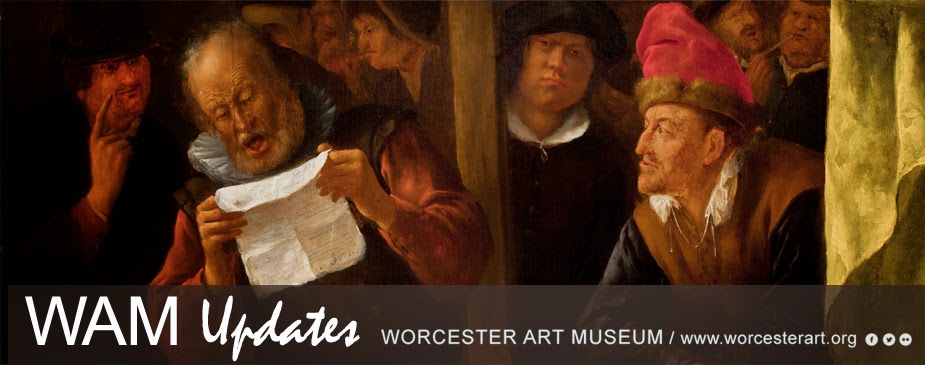Glazed blue and white ceramics were introduced to China in the Yuan dynasty (1279-1368) and later made their way to Europe by the end of the 16th century.² The blue pigment in the underglaze decoration, often cobalt oxide, was applied by brush or stenciling techniques to the ceramic prior to firing.³ While the blue and white color palette remained a constant, the type of clay, composition of the painted designs, and shape of the finished ceramics varied widely.
Pitcher with Lid, a blue and white ceramic with geometric designs, was brought to the George F. and Sybil H. Fuller Conservation Laboratory at WAM early last year (Fig.1). The lid of the pitcher was damaged and was fragmented into seven large and numerous small pieces (Fig. 2).
 |
| Fig 1. Pitcher from Pitcher with Lid. North African, Pitcher (n.d.). Ceramic. Bequest of Mary N. Perley 1904.26. |
 |
| Fig. 2. Lid from Pitcher with Lid before treatment. At the far left are the numerous small fragments in a glass dish and at the right are the seven large pieces. |
The goal of the conservation project was to restore the appearance and functionality of the ceramic lid. The surface of the ceramic was first cleaned to remove any grime. The fragments were aligned and readhered with a conservation grade acrylic adhesive.
Lastly, small losses were filled with an acrylic medium and retouched to match the sheen and color of the original glaze with dry pigments and acrylic varnishes (Figs. 3-6).
 |
| Fig. 3. Lid from Pitcher with Lid during treatment. The image shows the lid after all the fragments were consolidated and losses were filled with acrylic media. |
 |
| Fig. 4. This after-treatment image shows the lid after the acrylic media fills were in painted to create a seamless transition to the original ceramic. |
 |
| Fig. 5. Elle Friedberg, WAM Pre-Program Intern in Conservation, in paints white fills in the repaired ceramic. |
 |
| Fig. 6. Dry pigments and acrylic varnishes used for conservation treatment are set up on a palette. |
Great care was taken to ensure a seamless transition between fills and the original ceramic, making the conservator’s work nearly invisible (Fig. 7).
 |
| Fig. 7. Top view of ceramic lid after treatment. |
In addition to photo documentation, a record of treatment steps and materials is always maintained by the conservator. This transparency in the conservation process is not only good practice but also may assist a future conservator or scholar who wishes to know about the history of the object. Each step in a conservation treatment is not only chosen with the integrity of the object in mind but also is fully reversible. While the repaired ceramic lid is strong and stable, with the use of specific solvents these mends can be undone, returning the lid back into its seven fragments.
While Pitcher with Lid is listed in the Museum database as North African, possibilities of a Mexican origin also have been hypothesized in the past. More art historical research needs to be conducted on this object as the cultural origin also remains unsettled and we do not have a record of the year of its creation.
—By Elle Friedberg, WAM Pre-Program Intern in Conservation, and Paula Artal-Isbrand, WAM Objects Conservator
July 21, 2020
_______________________________
1. “Blue and White Pottery.” Wikipedia. Wikimedia Foundation, June 8, 2020. https://en.wikipedia.org/wiki/Blue_and_white_pottery
2. The Editors of Encyclopaedia Britannica. “Blue-and-White Ware.” Encyclopædia Britannica. Encyclopædia Britannica, Inc., October 20, 2011. https://www.britannica.com/art/blue-and-white-ware
3. “Blue and White Pottery.” Wikipedia.




















